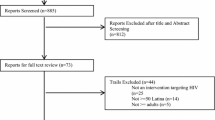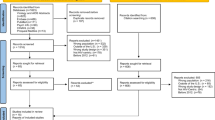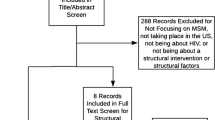Abstract
This first independent systematic review examined evidence for the effectiveness of the stepping stones intervention in HIV prevention. To reduce HIV transmission it addresses gender roles and promotes equitable relationships. Biomedical, behavioural and psychosocial outcomes extracted from six databases and ‘grey’ literature identified eight reports of seven studies (n = 14,630) from India, Gambia, S. Africa, Ethiopia, Angola, Tanzania, Uganda and Fiji. Infection incidence tested in the only RCT showed no significant reduction in HIV, although HSV-2 decreased. Condom use increased (two countries out of eight). Risk reduction results were mixed for declining alcohol misuse (two studies in three) and multiple partners (one in two). Communicating HIV information to partners, family or community improved (three studies from seven). Gender inequity was reduced in India (one in five), but stigma decreased in four studies. Future investigations of diverse cultures and older adults should select high quality biomedical and quality of life measures.
Resumen
La primera revisión sistemática independiente de evidencia cuantitativa, examina la efectividad de la intervención “stepping stones (SS)” la cual intenta reducir la propagación del VIH abordando los roles de genero y promoviendo relaciones equitativas dentro de las comunidades de países en desarrollo. Los resultados biomédicos, psicosociales y de comportamiento fueron extraídos de seis bases de datos y de literatura ¨gris¨. Ocho reportes de siete estudios (uno ECA) contenían 14,630 participantes viviendo en India, Gambia, Sur África, Etiopía, Angola, Tanzania, Uganda y Fiji. No se demostró cambio en la incidencia del VIH a pesar del incremento en el uso del condón, sin embargo HSV-2 disminuyo en el ECA. La información sobre VIH y la comunicación entre parejas, familias y comunidades mejoró. Cambios en la desigualdad de género y la violencia contra la mujer variaban entre culturas. El alto riesgo en el abuso de alcohol, sustancias y estigmatización ha disminuido pero los índices de parejas múltiples y sexo transaccional fueron mixtos. Se necesitan estudios de calidad con más culturas y adultos mayores medidos según ciertos estándares biomédicos y sujetos a medidas de calidad de vida subjetiva.

Similar content being viewed by others

References
Global HIV Prevention Working Group. Behaviour Change and HIV Prevention: (Re) considerations for the 21st century. 2008.
UNAIDS. AIDS epidemic update. Joint United Nations Programme on HIV/AIDS. UNAIDS, Geneva; 2007.
Bradley J, Girish M, Bhattaacharjee P, Ramesh BM. Evaluation of SS in Karnataka. Banglore: Karnataka Health Promotion Trust; 2009.
Kirby DB, Laris B, Rolleri LA. Sex and HIV education programmes: their impact on the sexual behaviour of young people. J Adolesc Health. 2007;40(3):206–17.
Crepaz N, Horn AK, Rama SM, et al. The efficacy of behavioral interventions in reducing HIV risk sex behaviours and incident sexually transmitted disease in black and Hispanic sexually transmitted disease clinic patients in the United States: a meta-analytic review. STD’s. 2007;34(6):319–32.
Crepaz N, Lyles CM, Wolitski RJ, et al. Do prevention interventions reduce HIV risk behaviours among people living with HIV? A meta-analytic review of controlled trials. AIDS. 2006;20(2):143–57.
Darbes L, Crepaz N, Lyles C, Kennedy G, Rutherford G. The efficacy of behavioral interventions in reducing HIV risk behaviours and incident sexually transmitted diseases in heterosexual African Americans. AIDS. 2008;22(10):1177–94.
Herbst JH, Sherba RT, Crepaz N, et al. A meta-analytic review of HIV behavioural interventions for reducing sexual risk behaviour of men who have sex with men. AID. 2005;39(2):228–41.
McCoy SL, Kangwende RA, Padian NS. Behaviour change interventions to prevent HIV infection among women living in low and middle income countries: a systematic review. AIDS Behav. 2010;14:469–82.
Coates TJ, Richter L, Caceres C. Behavioural strategies to reduce HIV transmission: how to make them work better. Lancet. 2008;372(9639):669–84.
Kippax S, Race K. Sustaining safe practice: twenty years on. Soc Sci Med. 2003;57:1–12.
Slutkin G, Okware S, Naamara W, et al. How Uganda reversed its HIV epidemic. AIDS Behav. 2006;10:351–60.
UNAIDS. HIV prevention needs and success in Senegal, Thailand and Uganda. Joint United Nations Programme on HIV/AIDS. UNAIDS, Geneva; 2006.
UNAIDS. Report on the Global AIDS epidemic: a UNAIDS 10th anniversary special edition. Joint United Nations Programme on HIV/AIDS. UNAIDS, Geneva; 2006.
UNAIDS. Report on the Global AIDS epidemic. Joint United Nations Programme on HIV/AIDS. UNAIDS, Geneva; 2008.
UNAIDS. Report on the Global AIDS epidemic. Joint United Nations Programme on HIV/AIDS. UNAIDS and the World Health Organisation, UNAIDS, Geneva; 2009.
UNAIDS. Report on the Global AIDS epidemic. Joint United Nations Programme on HIV/AIDS. UNAIDS, Geneva; 2010.
Auerbach JD, Coates TJ. HIV prevention research: accomplishments and challenges for the third decade of AIDS. Am J Public Health. 2000;90:1029–32.
Dunkle KL, Jewkes RK, Brown HC, Gray GE, McIntyre JA, Harlow SD. Gender-based violence, relationship power and risk of prevalent HIV infection among women attending antenatal clinics in Soweto, South Africa. The Lancet. 2004;363:1415–21.
Pettifor AE, Hudgens MG, Levandowski BA, Rees HV, Cohen MS. Highly efficient HIV transmission to young woman in South Africa. AIDS. 2007;21:861–5.
World Health Organisation and UNAIDS. Violence against women and HIV/AIDS: critical intersections. Intimate partner violence and HIV/AIDS. The global coalition of women and AIDS. World Health Organisation. Information Bulletin Series N1; 2004.
World Health Organisation. Integrating gender into HIV/AIDS programmes: a review. Department of Gender and Women’s Health; Family and Community Health. www.who.int/hiv/pub/prev_care/en/IntegratingGender.pdf. (2003). Accessed 15 June 2010 (on-line publication).
Jarjue MS, Badgie K, Jobarteh A, et al. Participatory review of changes after a stepping stones workshop in an Islamic context. The Gambia, February, 2000. http://steppingstonesfeedback.org/index.php/page/resources/7/SS_Review_Gambia_2000.pdf. (2000). Accessed 15 June 2010 (on-line publication).
Jewkes R, Dunkle K, Nduna M, et al. Factors associated with HIV sero-status in young rural South African women: connections between intimate partner violence and HIV. Int J Epidemiol. 2006;35:1461–8.
Willis L, Daisley J. Springboard. Stroud: Hawthorn Press; 1990.
Welbourn A. Stepping stones. A training package on HIV/AIDS, communication and relationship skills. London: ActionAid London (Strategies for Hope Training, Series 1); 1995.
Boal A. Games for actors and non-actors. London: Routledge; 1992.
Jewkes R, Wood K, Duvvury N. ‘I woke up after I joined stepping stones’: meanings of an HIV behavioural intervention in rural South African young peoples lives. Health Educ Res. 2010;24(6):1074–84.
Wallace T. Evaluating stepping stones. A review of existing evaluations and ideas for future M&E work. London: ActionAid International; 2006. http://steppingstonesfeedback.org/index.php/page/resources/7/SS_ActionAid_EvaluatingSteppingStones_TWallace_2006.pdf.. Accessed 8 June 2010 (on-line).
Bradley JE, Bhattacharjee P, Ramesh BM, Girish M, Das AK. Evaluation of stepping stones as a tool for changing knowledge, attitudes and behaviours associated with gender, relationships and HIV risk in Karnataka, India. BMC Public Health. 2011;11:496–507.
Pacific Regional HIV/AIDS Project. Evaluation of the pilot stepping stones programme. Fiji. 2007. http://steppingstonesfeedback.org/index.php/page/resources/7/SS_SPC_Evaluation_Fiji_2007.pdf.. Accessed 15 June 2010 (on-line publication).
Jewkes R, Nduna M, Levin J, Jama N. A cluster randomized-controlled trial to determine the effectiveness of stepping stones in preventing HIV infection and promoting safer sexual behaviour amongst youth in the rural Eastern Cape, South Africa: trial design, methods and baseline findings. Trop Med Int Health. 2006;11(1):3–16.
Jewkes R, Nduna M, Levin J, et al. Evaluation of stepping stones: a gender transformative HIV prevention intervention. Cape Town: MRC; 2007.
Jewkes R, Nduna M, Levin J, et al. Impact of stepping stones on incidence of HIV and HSV-2 and sexual behaviour in rural South Africa: cluster randomized controlled trial. BMJ. 2008;337:a506.
Juni P, Altman D, Egger M. Assessing the quality of randomized controlled trials. Systematic reviews in health care—meta-analysis in context. In: Egger M, Davey-Smith G, Altman D, editors. London: BMJ Books; 2001.
Khan K, Kunz R, Kleijnen J, Antes G. Systematic reviews to support evidence-based medicine. London: Hodder Arnold; 2011.
Hadjipateras A, Akullu H, Owero J, Dendo MdeF, Nuenga C. ‘Joining hands’: integrating gender and HIV/AIDS. Report of an ACORD project using stepping stones in Angola, Tanzania and Uganda. ACORD. Uganda: Hasap Publications; 2006. http://steppingstonesfeedback.org/index.php/page/resources/7/SS_ACORD_JoiningHands_2006.pdf.. Accessed 15 June 2010 (on-line).
Pain K, Hart G, Jawo M, et al. ‘Before we were sleeping, now we are awake’. Preliminary evaluation of the stepping stones sexual health programme in Gambia. Afr J AIDS Res. 2002;1:41–52.
Bhattacharjee P, Costigan A. Stepping stones review report. Harar, Ethiopia, save the children UK (SCUK); 2005. http://steppingstonesfeedback.org/index.php/page/resources/7/SS_SaveTheChildren_Evaluation_Ethiopia_2005.pdf.. Accessed 5 June 2010 (on-line publication).
Powers KA, Pool C, Pettifor AE, Cohen MS. Rethinking the heterosexual infectivity of HIV-1: a systematic review and meta-analysis. Lancet Inf Dis. 2008;8(9):533–63.
Pitkerton SD, Layde PM, DiFrancisco W, Chesson HW. All STDs are not created equal: an analysis of the differential effects of sexual behaviour changes on different STDs. Int J STD/AIDS. 2003;14(5):320–8.
Ross DA, Changalucha J, Obasi AIN, et al. Biological and behavioural impact of an adolescent sexual health intervention in Tanzania: a community-randomized trial. AIDS. 2007;21(14):1943–55.
Fordyce WE. Behavioral methods for chronic pain and illness. St Louis: Mosby; 1976.
UNAIDS. Agenda for accelerated country action for women, girls, gender equality and HIV. Geneva: UNAIDS Joint UN programme on HIV/AIDS; 2010. http://data.unaids.org/pub/Agenda/2010/20100226_jc1794_agenda_for_accelerated_country_action_en.pdf.
World Health Organisation. Changing men’s behaviour can improve women’s health. Bull WHO. 2007;85(7). www.who.int/bulletin/volumes/85/7/07-010707.pdf.. Accessed 15 June 2010 (on-line publication).
O’Connell KA, Saxena S, Skevington SM, the WHOQOL-HIV Group. WHOQOL-HIV for quality of life assessment among people living with HIV and AIDS: results from the field test. AIDS Care. 2004;16(7):882–9.
O’Connell K, Skevington SM, the WHOQOL-HIV Group. An international quality of life instrument to assess wellbeing in adults who are HIV-positive: a short form of the WHOQOL-HIV (31 items). AIDS Behav. 2012;16:452–460.
Skevington SM, Sartorius N, Amir M, the WHOQOL Group. Developing methods for assessing quality of life in different cultural settings: the history of the WHOQOL instruments. Soc Psychiat Psychiatr Epidemiol. 2004;39(1):1–8.
Acknowledgments
The authors are very grateful to SS researchers/administrators who assisted us in finding information and Dr Lydia Ruprecht at UNESCO for her comments and support. The authors thank Lilly Barrera for translating the abstract. This research was presented as part fulfillment of a Masters in Health Psychology awarded to Dr Elena Sovetkina by University of Bath, Bath, UK.
Author information
Authors and Affiliations
Corresponding author
Rights and permissions
About this article
Cite this article
Skevington, S.M., Sovetkina, E.C. & Gillison, F.B. A Systematic Review to Quantitatively Evaluate ‘Stepping Stones’: A Participatory Community-based HIV/AIDS Prevention Intervention. AIDS Behav 17, 1025–1039 (2013). https://doi.org/10.1007/s10461-012-0327-6
Published:
Issue Date:
DOI: https://doi.org/10.1007/s10461-012-0327-6



